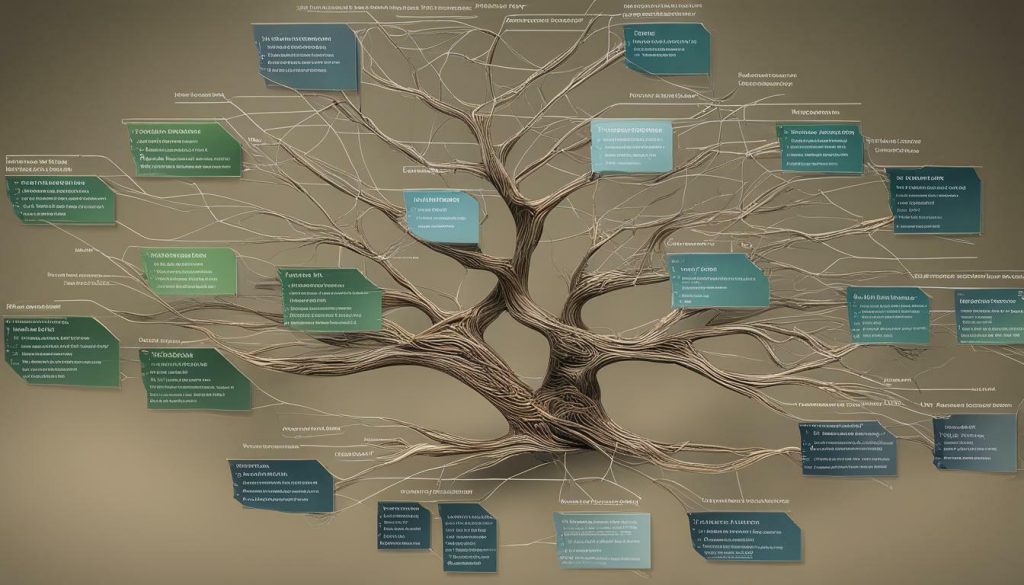Organizing documents is crucial for the smooth execution of HVAC projects. By implementing efficient document organization techniques, you can streamline your operations and boost overall efficiency. Having a centralized document management system and adopting a digital file structure can significantly improve collaboration and accessibility. In this article, we will explore the importance of document organization in HVAC projects and provide valuable tips on how to optimize your document management process.
Key Takeaways:
- Utilize a centralized document management system to keep all HVAC documents in one place.
- Implement a digital file structure, such as cloud-based storage, for easy access.
- Establish a unique naming structure and number coding system for efficient searchability.
- Create a standardized workflow and designate a document manager to ensure timely information distribution.
- Ensure accessibility and record keeping by making HVAC documents easily available to key partners.
By following these key takeaways, you can enhance your document organization process and maximize your efficiency in HVAC projects.
The Importance of Document Management in HVAC Projects
Efficient document management is a fundamental aspect of HVAC projects, ensuring proper document control, record keeping, and seamless collaboration across teams. Organizing and managing HVAC documents effectively can significantly enhance project productivity and reduce errors. In this section, we will explore the significance of document management in HVAC projects and highlight essential practices to implement.
One of the key benefits of effective document management is proper document control. By having a centralized system that keeps all HVAC documents in one place, you can ensure that everyone has access to the most up-to-date versions of project-related files. This centralized approach minimizes the risk of using outdated information, resulting in smoother collaboration and better decision-making.
Record keeping is another crucial aspect of document management in HVAC projects. By maintaining a well-organized record of all project-related documents, including contracts, permits, and technical specifications, you can easily refer back to important information whenever needed. This helps in maintaining compliance with regulations, tracking project progress, and resolving any disputes that may arise.
To effectively manage HVAC documents, implementing a digital file structure is highly recommended. Cloud-based storage allows for easy access to documents from anywhere, at any time. It also enables real-time collaboration, allowing team members to work on documents simultaneously. Additionally, using document management software and automation tools can streamline processes, reducing manual effort and improving overall efficiency.

| Benefits of Effective Document Management |
|---|
| Ensures easy access to up-to-date documents |
| Minimizes the risk of using outdated information |
| Facilitates collaboration and decision-making |
| Maintains compliance with regulations |
| Tracks project progress and resolves disputes |
| Enables real-time collaboration |
| Streamlines processes and improves overall efficiency |
Choosing the Right Digital File Structure for HVAC Documents
Selecting the right digital file structure is essential for efficient HVAC document organization. Cloud-based storage, document management software, and automation tools can significantly enhance productivity and accessibility. By implementing these technologies, you can streamline your document management process and improve collaboration across your HVAC projects.
Cloud-based storage offers a secure and centralized location for storing your HVAC documents. It allows you to access your files from anywhere, at any time, eliminating the need for physical storage or local servers. With cloud-based storage, you can easily share documents with team members, subcontractors, or clients, fostering better collaboration and reducing the risk of version control issues.

Document management software provides additional features and functionalities that simplify document organization. These tools allow you to categorize your files, add metadata, and implement version control. With document management software, you can easily search for specific documents, track revisions, and ensure that everyone has access to the most up-to-date information.
To further enhance your document management process, consider implementing automation tools. These tools can automate repetitive tasks, such as file naming, folder creation, and document distribution. By reducing manual work, automation tools save time and minimize the risk of human error.
| Benefits of a Digital File Structure for HVAC Documents |
|---|
| Improved accessibility and collaboration |
| Streamlined document organization and retrieval |
| Enhanced version control and document tracking |
| Time-saving through automation |
By adopting cloud-based storage, document management software, and automation tools, you can transform your HVAC document organization. These technologies provide a solid foundation for efficient collaboration and help boost productivity across your projects. Remember, selecting the right digital file structure is the key to unlocking the full potential of your HVAC document management system.
Establishing a Naming and Coding System for HVAC Documents
Implementing a standardized naming and coding system for your HVAC documents is crucial for efficient organization and quick retrieval of information when needed. By following consistent file naming conventions, you can ensure that your files are easily identifiable and searchable.
When creating file names, it is important to use descriptive names that indicate the content of the document. Consider including relevant details such as project names, dates, and location information. This will help you quickly locate specific documents and understand their context without having to open each one. For example, instead of naming a file “HVAC Document,” you could use a more descriptive name such as “Smith Residence HVAC Plans 2022.”
Additionally, using a number coding system can further enhance the organization of your HVAC documents. Assigning unique codes to different types of documents, such as drawings, specifications, or contracts, allows for easy categorization and sorting. For example, you could use the prefix “DRW” for drawings, “SPC” for specifications, and “CTR” for contracts, followed by a sequential number. This coding system provides consistency and clarity, making it easier to navigate through your document repository.
| Document Type | File Name Example |
|---|---|
| Drawings | DRW001_Smith_Residence_HVAC_Plans |
| Specifications | SPC001_HVAC_Specifications |
| Contracts | CTR001_HVAC_Contract |
By following a standardized naming and coding system, you can streamline your document organization process, save time searching for specific files, and avoid confusion or duplication of documents. This level of organization is essential for the success of your HVAC projects and ensures that information is readily accessible for collaboration and decision-making.

Benefits of a Standardized Naming and Coding System for HVAC Documents
- Efficient organization and retrieval of files
- Clear and descriptive file names provide context and understanding
- Consistent file naming conventions improve collaboration and communication
- Easy categorization and sorting of documents using number coding system
- Prevents duplication of documents and confusion
Creating a Standardized Workflow for Document Distribution
Establishing a standardized workflow for HVAC document distribution is vital to ensure that information is promptly delivered to the appropriate parties involved in the project. By implementing a clear and consistent process, you can avoid delays, miscommunications, and potential errors. Designating a document manager who oversees the distribution of documents and ensures that all stakeholders receive the necessary information is key to a well-organized workflow.
To streamline document distribution, it is important to utilize digital tools and platforms that enable efficient sharing and collaboration. Cloud-based storage solutions offer a centralized location for all HVAC documents, making them easily accessible to team members regardless of their physical location. This eliminates the need for manual document sharing, reduces the risk of outdated information being circulated, and improves overall project efficiency.
| Benefits of Standardized Workflow for Document Distribution: |
|---|
| 1. Improved communication and collaboration among team members. |
| 2. Reduced chances of errors and miscommunications. |
| 3. Streamlined access to up-to-date documents for all stakeholders. |
| 4. Increased efficiency in project management and execution. |
Furthermore, it is essential to establish a naming convention that allows for easy identification of documents and their content. Using descriptive file names that indicate the document’s purpose, project name, and relevant dates or location information can significantly improve searchability and retrieval. Consistency in file naming across the organization ensures everyone can locate the required documents promptly, thereby enhancing overall productivity.
By establishing a standardized workflow and utilizing digital tools, you can optimize document distribution in HVAC projects. Remember to assign a document manager, leverage cloud-based storage, implement a consistent naming convention, and regularly update and review the workflow as needed. These practices will help ensure that information is effectively communicated among team members, leading to successful project outcomes.

Ensuring Accessibility and Record Keeping with Digital Documentation
By maintaining accessibility and creating a digital paper trail, you can enhance collaboration and ensure that critical HVAC documents are readily available to all key partners involved in the project. Having easy access to up-to-date documents is crucial for timely decision-making and efficient project management. Digital documentation allows for real-time updates and eliminates the need for physical paperwork, reducing the risk of important documents getting misplaced or lost.
One way to ensure accessibility is by utilizing cloud-based storage for your HVAC documents. Storing documents in the cloud provides a centralized location that can be accessed from anywhere, anytime. This is particularly beneficial when working with remote teams or when multiple stakeholders need access to the same documents. Cloud storage also offers additional security measures, such as data encryption and regular backups, to protect your documents from loss or unauthorized access.
| Key Benefits of Cloud-based Storage for HVAC Documents: |
|---|
| Easy access to documents from anywhere, anytime |
| Reduced risk of document loss or misplacement |
| Enhanced collaboration among team members |
| Improved document security with encryption and backups |
In addition to accessibility, keeping a digital paper trail is essential for record keeping and compliance purposes. It provides a comprehensive history of document revisions, approvals, and interactions, ensuring transparency and accountability throughout the project lifecycle. A digital paper trail can also be invaluable when resolving disputes or addressing legal requirements.

Key Considerations for Maintaining a Digital Paper Trail:
- Save and record all versions of important HVAC documents
- Track document revisions and approvals
- Maintain an audit trail of document interactions
- Ensure proper document archiving and retention
By effectively managing digital documentation, you can streamline communication, boost collaboration, and ensure that all key partners have the necessary information at their fingertips. Embracing digital solutions not only enhances efficiency but also contributes to the long-term success of your HVAC projects.
Regularly Reviewing and Improving Document Organization
Document organization should be an ongoing process that is consistently reviewed and improved upon to optimize efficiency and facilitate easy document retrieval. By regularly assessing and enhancing your HVAC document management system, you can ensure that your projects run smoothly and effectively.
One important aspect of document organization is following file naming conventions. It is recommended to use descriptive names that indicate the content of the document, and consider including dates, project names, and location information in file names. This not only helps with easy searchability but also provides context and clarity when retrieving specific documents.
File Naming Conventions
Following consistent file naming conventions is crucial for maintaining a logical and easily navigable document structure. By using a standardized naming structure, you not only make it easier to locate specific files but also establish a systematic approach that can be easily understood by all team members. Consider implementing a number coding system alongside your naming structure to further enhance document retrieval.
Another important aspect of document organization is using a logical folder structure. Create folders that align with your project phases, such as design, installation, and maintenance. Within each folder, categorize your documents based on their specific purpose or department. Additionally, separate ongoing and completed work to keep your document library well-organized and clutter-free.

| Benefits of Regular Document Organization | |
|---|---|
| Increased efficiency | Organized documents are easier to find and access, reducing time wasted searching for information. |
| Better collaboration | A centralized document management system fosters collaboration among team members by providing easy access to up-to-date documents. |
| Enhanced productivity | Efficient document retrieval ensures that tasks and deadlines are met promptly, leading to improved productivity. |
| Reduced errors | With proper document organization, the chances of errors due to misinformation or outdated documents are minimized. |
By regularly reviewing and improving your document organization process, you can ensure that your HVAC projects are executed smoothly and effectively. Follow file naming conventions, establish a logical folder structure, and separate ongoing and completed work. Taking these steps will optimize efficiency, facilitate easy document retrieval, and contribute to the overall success of your projects.
Backing Up and Reviewing HVAC Documents
Regularly backing up your HVAC documents and reviewing them helps maintain an efficient document management system and avoid clutter or the retention of unnecessary files. By ensuring that your documents are properly backed up, you can minimize the risk of data loss and preserve important information for future reference.
One effective way to back up your HVAC documents is to utilize cloud-based storage services. These services provide a secure and convenient method for storing and accessing your documents from anywhere, at any time. With automatic backups and version control features, you can rest assured that your documents are protected and accessible, even in the event of hardware failures or accidents.
In addition to regular backups, it is important to review your HVAC documents periodically. This involves going through your files and folders to identify any unnecessary or outdated documents that can be safely deleted. By doing so, you can declutter your document management system and improve overall efficiency. It is recommended to establish a schedule for document review, whether it be quarterly, semi-annually, or annually, to ensure that your system remains organized and up-to-date.
| Benefits of Regularly Backing Up and Reviewing HVAC Documents |
|---|
| Prevention of data loss and preservation of important information |
| Efficient document management system with reduced clutter |
| Improved accessibility and availability of documents |
| Enhanced document security and protection against hardware failures and accidents |
By incorporating regular backups and reviews into your document management process, you can maintain an organized and efficient system that supports collaboration, improves productivity, and reduces the risk of data loss. Take the time to establish a backup routine and set aside dedicated periods for document review to ensure the continued success of your HVAC projects.

Adding Proper Documentation and Metadata
Proper documentation and metadata are essential elements for effective use and understanding of HVAC documents, providing context and facilitating seamless collaboration. By including thorough documentation, you ensure that all relevant information is captured and communicated clearly. Metadata, on the other hand, adds valuable information about the data within the documents, making it easier to search, organize, and retrieve specific information.
When adding documentation, it is important to include details such as project descriptions, client names, dates, and any other pertinent information that provides context. This allows anyone accessing the document to quickly understand its purpose and relevance. Additionally, consider adding notes or comments to elaborate on specific sections, highlight key points, or provide further explanations.
To effectively utilize metadata, you can include tags or labels that describe the content, format, and purpose of the document. This helps categorize and classify the documents for easy retrieval. For example, you can use tags such as “equipment specifications,” “work permits,” or “project timelines.” By utilizing metadata, you can create a comprehensive system that allows for efficient searching and filtering of documents based on specific criteria.
| Benefits of Proper Documentation and Metadata |
|---|
| 1. Improved searchability and retrieval of information |
| 2. Facilitated collaboration and seamless information sharing |
| 3. Enhanced understanding of document content and context |
| 4. Efficient categorization and filtering of documents |
| 5. Streamlined decision-making processes |
By ensuring proper documentation and metadata, you create a robust system that maximizes the benefits of your HVAC documents. This, in turn, supports the overall success and efficiency of your projects.

Utilizing Reference Management Software
Utilizing reference management software and adhering to reference conventions play a crucial role in maintaining accurate and well-documented HVAC projects. With the increasing amount of information available, it’s essential to have a system that helps you manage and organize your references efficiently. Reference management software allows you to store and organize your references in one central location, making it easier to track and cite your sources.
One of the key benefits of reference management software is its ability to generate citations and bibliographies in various citation styles. Whether you’re using APA, MLA, or any other citation style, reference management software can automatically format your references according to the required style guidelines. This saves you valuable time and ensures consistency in your citations.
Furthermore, reference management software often provides features for importing and exporting references from online databases and websites. This allows you to easily gather and store relevant references from different sources, making it convenient to build your reference library for future projects. Additionally, some software even offers PDF annotation and note-taking capabilities, allowing you to add comments and highlights directly to your references.
Benefits of Utilizing Reference Management Software
Here are some key benefits of utilizing reference management software for your HVAC projects:
- Efficient organization of references in a central location
- Automated citation generation in different citation styles
- Import and export capabilities for easy reference collection
- PDF annotation and note-taking features for enhanced research
- Collaboration tools to share references with team members
By implementing reference management software and following reference conventions, you can streamline your research process and ensure the accuracy and integrity of your HVAC projects.
| Reference Management Software | Key Features |
|---|---|
| Zotero | – Free and open-source – Browser extension for easy reference capture – Collaboration features |
| Mendeley | – Reference organization and annotation – Social networking features – PDF reader and note-taking capabilities |
| EndNote | – Extensive citation style options – Integration with online databases – Team collaboration features |
Choose the reference management software that best suits your needs and take advantage of its features to simplify your workflow and ensure the accuracy and reliability of your HVAC projects.

Conclusion
Organizing HVAC documents effectively is essential for the success of your projects. By implementing the strategies discussed in this article, you can streamline operations, improve collaboration, and boost overall efficiency.
A centralized document management system is crucial, as it keeps all your HVAC documents in one place. This system should earn buy-in from your employees, ensuring that everyone understands the importance of organizing and maintaining the documents.
Utilizing a digital file structure, such as cloud-based storage, allows for easy access to up-to-date documents from anywhere. Implementing a unique naming structure and number coding system ensures easy searchability, saving you time and effort in locating specific documents.
Creating a standardized workflow and designating someone to manage the system helps ensure that information reaches the right individuals at the right time. This eliminates confusion and streamlines the document distribution process, leading to better collaboration and project efficiency.
Remember to make your documents easily accessible to key partners and stakeholders. Instead of deleting documents, save and record them for a digital paper trail. Regularly review and improve your document organization, following consistent file naming conventions and maintaining a logical folder structure.
By backing up your files and regularly reviewing them, you can avoid keeping unnecessary documents and ensure that your document management system remains efficient. Adding proper documentation and metadata to your files provides context and allows for a better understanding and use of the data within.
Consider utilizing reference management software and following reference conventions to keep track of your sources and citations accurately. Consistency in file naming and organization is crucial for effective document management in HVAC projects.
By implementing these strategies, you can optimize your document organization process, boost efficiency, and ensure the success of your HVAC projects.
FAQ
Why is organizing documents for HVAC projects important?
Organizing documents for HVAC projects is crucial for collaboration and efficiency. It ensures that all relevant information is easily accessible and allows for effective communication among team members.
What is the best way to organize HVAC documents?
Using a digital file structure, such as cloud-based storage, is an effective way to organize HVAC documents. It allows for easy access to up-to-date information and ensures that documents are centrally located.
How can I make searching for documents easier?
Implementing a unique naming structure and number coding system can help make searching for documents easier. By using descriptive names that indicate content and including relevant information like dates, project names, and location, documents can be easily searchable.
How can I ensure proper distribution of documents?
Creating a standardized workflow and designating someone to manage the document system can help ensure information is delivered to the right person at the right time. It helps streamline the process and prevents any miscommunication or delays in sharing important documents.
Should I delete old documents?
No, it is recommended to save and record old documents for a digital paper trail. This ensures that all information is preserved and can be referenced if needed in the future. Deleting documents may result in the loss of valuable information.
How often should I review and improve my document organization?
Document organization should be an ongoing process that is regularly reviewed and improved upon. It is important to stay updated with the changing needs of your HVAC projects and make necessary adjustments to the document management system.
What file naming conventions should I follow?
It is recommended to follow consistent file naming conventions. Use descriptive names that indicate the content of the document, and consider including dates, project names, and location information in file names for easy identification.
How should I separate ongoing and completed work?
Separating ongoing and completed work can help with organization. You can create separate folders or use specific tags to distinguish between the two. This ensures that completed work is not mixed with ongoing projects and makes it easier to locate relevant documents.
How can I ensure the safety of my documents?
It is important to regularly backup your files and ensure that they are stored in a secure location. This helps protect against data loss and provides a backup in case of any unforeseen events or system failures.
Why is metadata important for HVAC documents?
Adding proper documentation and metadata to HVAC documents provides context and allows for the proper understanding and use of the data within the documents. It helps ensure that the information is accurate and can be effectively utilized.
What is reference management software and why is it useful?
Reference management software helps keep track of sources and citations used in HVAC documents. It allows for easy referencing and ensures that proper credit is given to the original sources. Following reference conventions is important to maintain accuracy and credibility.





0 Comments